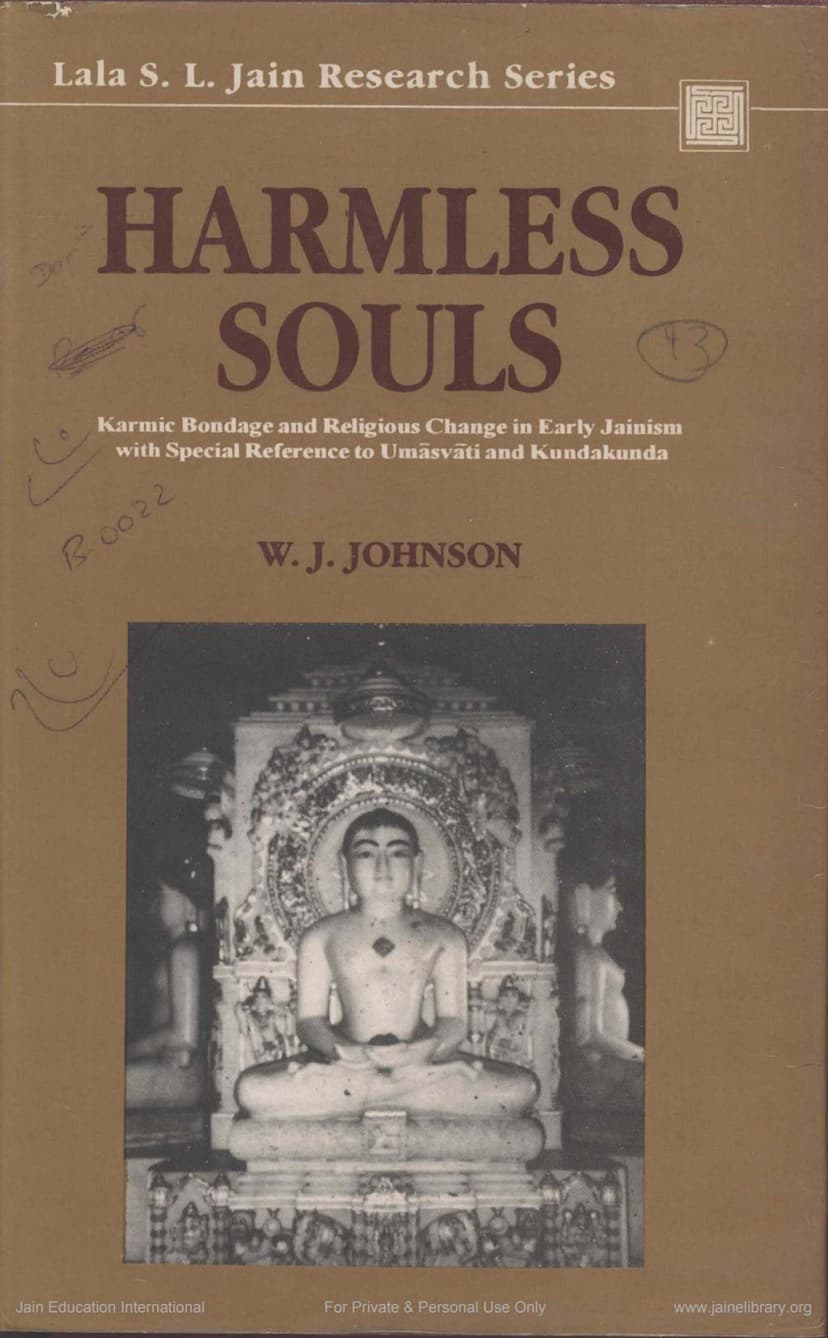Harmless Soul
Added to library: September 1, 2025

Summary
Here's a comprehensive summary of W.J. Johnson's "Harmless Souls: Karmic Bondage and Religious Change in Early Jainism," based on the provided text excerpts:
Overall Focus:
"Harmless Souls" by W.J. Johnson examines the evolution of Jainism, particularly its early development, by focusing on changes in its doctrinal understanding of karmic bondage and the path to liberation. The book specifically analyzes how these concepts were articulated in the early Svetambara canon, Umāsvāti's influential Tattvārtha Sūtra, and the major works of the Digambara teacher Kundakunda.
Core Argument and Key Themes:
The central argument is that while significant doctrinal shifts occurred in early Jainism regarding the mechanisms of karma and liberation, these changes were carefully managed to preserve the core ascetic practices and the distinct identity of the Jain community. Johnson highlights the tension between the strict asceticism of Jainism's origins and the need to accommodate a growing lay following.
Key themes explored include:
- The Problem of Bondage: The book delves into how Jainism explains why souls become bound by karmic matter. It traces the shift from an early emphasis on physical action (yoga) as the primary cause of bondage to a later understanding that passions (kaṣāya) and internal states became central to the mechanism of bondage.
- Himsā (Violence/Harm): A core Jain principle is ahimsā (non-violence). Johnson analyzes how the understanding of himsā evolved, particularly the shift from any harm to living beings, regardless of intention or physical action, being binding, to himsā being defined more by the presence of passions and internal states.
- The Role of Intention and Attitude: The book meticulously tracks the increasing importance of internal states like intention, passion, and attitude (moha, rāga, dveṣa) in the process of karmic bondage and liberation, particularly in the works of Umāsvāti and Kundakunda.
- Umāsvāti's Tattvārtha Sūtra: Johnson presents this text as a crucial "reconciliation" between ascetic and lay concerns. He highlights Umāsvāti's innovation in formulating a technical doctrine of karmic bondage, emphasizing the role of kaṣāya and the distinction between sāmparāyika (long-term, rebirth-causing karma) and īryāpatha (short-term, non-binding karma) karma.
- Kundakunda's Contribution: The book examines Kundakunda's unique contributions, particularly his development of the upayoga doctrine in the Pravacanasāra and his radical emphasis on self-knowledge (jñāna) and meditation (dhyāna) as the direct means to liberation in the Samayasāra. Johnson argues that Kundakunda's work shows a significant "internalization" of religious practice, shifting the focus from external asceticism to internal mental states and gnosis.
- The Niscaya and Vyavahāra Nayas (Two Truths Doctrine): Johnson analyzes how Kundakunda utilizes the vyavahāra-niscaya distinction, often in ways that seem contradictory and move beyond orthodox Jaina anekāntavāda. He notes Kundakunda's more radical application of the niscaya (absolute truth) view, suggesting that the self is inherently pure and separate from matter, thus potentially rendering the traditional karma theory and external ascetic practices less critical for liberation.
- Preservation of Practice and Identity: Despite the theoretical shifts, Johnson concludes that Jaina ascetic practices were largely preserved. This was due to the need for a tangible demonstration of inner states, the social identity of the Jain community, and the influence of commentators who tempered the most radical implications of Kundakunda's teachings. The external practices, while perhaps "ritualized" or considered less soteriologically essential from a purely internal perspective, continued to serve a vital social function as markers of Jain identity.
Structure of the Book:
The book is structured into four main parts:
- Part I: Early Jainism: Discusses the foundational doctrines of early Jainism as found in the Svetambara canon, emphasizing the strict asceticism, the ubiquity of souls, and the binding nature of physical action. It contrasts early Jaina views with early Buddhism.
- Part II: Umāsvāti's Jainism: Focuses on the Tattvārtha Sūtra as a pivotal text that synthesized Jaina doctrine and attempted to reconcile ascetic and lay concerns through a more systematic understanding of karma and the introduction of the kaṣāya doctrine.
- Part III: Kundakunda: The Pravacanasāra: Analyzes Kundakunda's Pravacanasāra, highlighting his development of the upayoga doctrine and the increasing emphasis on internal states and meditation as the means to liberation.
- Part IV: Kundakunda: The Samayasāra: Explores Kundakunda's Samayasāra, noting its more radical application of the vyavahāra-niscaya doctrine, its apparent borrowing from other Indian philosophical traditions, and its implications for understanding the self, knowledge, and liberation as primarily internal realizations.
Conclusion:
"Harmless Souls" demonstrates that early Jainism underwent significant doctrinal evolution, particularly in its understanding of karmic bondage. While theoretical shifts, especially those found in Kundakunda's works, moved towards an internal, knowledge-based path to liberation, the core ascetic practices and the social identity of the Jain community remained paramount, ensuring the continued practice of himsā-avoidance through external discipline. The book argues that the perceived contradictions and tensions within Jaina philosophy are often a result of this dynamic interplay between profound theoretical developments and the enduring need to preserve religious identity and practice.